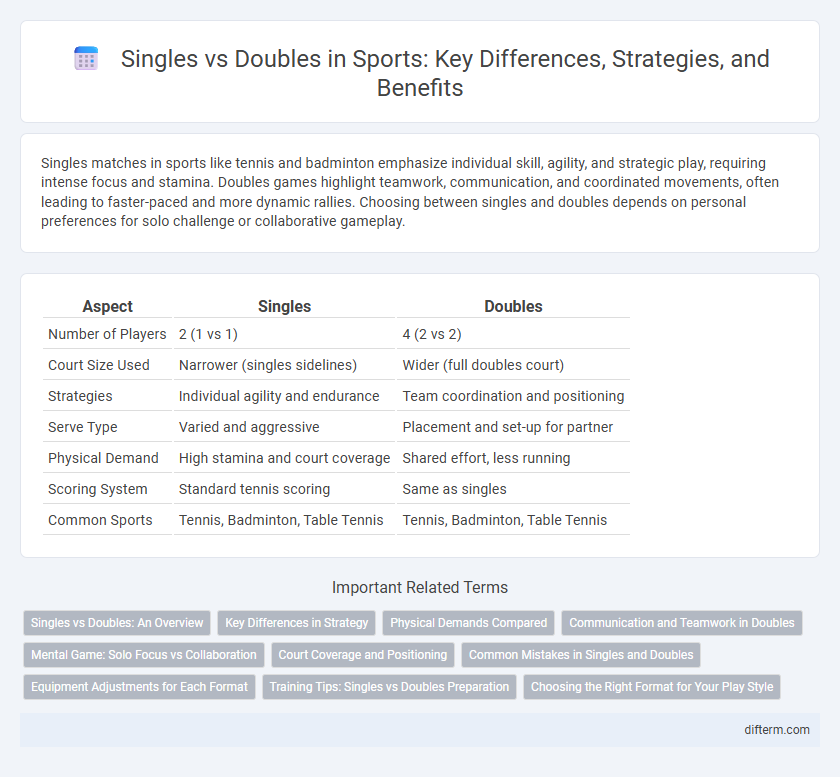Singles matches in sports like tennis and badminton emphasize individual skill, agility, and strategic play, requiring intense focus and stamina. Doubles games highlight teamwork, communication, and coordinated movements, often leading to faster-paced and more dynamic rallies. Choosing between singles and doubles depends on personal preferences for solo challenge or collaborative gameplay.
Table of Comparison
| Aspect | Singles | Doubles |
|---|---|---|
| Number of Players | 2 (1 vs 1) | 4 (2 vs 2) |
| Court Size Used | Narrower (singles sidelines) | Wider (full doubles court) |
| Strategies | Individual agility and endurance | Team coordination and positioning |
| Serve Type | Varied and aggressive | Placement and set-up for partner |
| Physical Demand | High stamina and court coverage | Shared effort, less running |
| Scoring System | Standard tennis scoring | Same as singles |
| Common Sports | Tennis, Badminton, Table Tennis | Tennis, Badminton, Table Tennis |
Singles vs Doubles: An Overview
Singles tennis emphasizes individual skill, strategy, and endurance as players cover the entire court alone, requiring intense focus on stamina and precision. Doubles tennis involves teamwork, communication, and positioning, with partners coordinating to cover the court efficiently and execute combined tactics. The choice between singles and doubles impacts gameplay dynamics, player specialization, and competitive strategies in professional and recreational settings.
Key Differences in Strategy
Singles tennis demands a focus on individual court coverage, emphasizing baseline endurance and precise shot placement to exploit an opponent's weaknesses. Doubles strategy prioritizes teamwork, coordinated net play, and quick reflexes to control the front court and apply constant pressure on opponents. Effective communication and synchronized movement are essential to capitalize on court angles and create offensive opportunities in doubles matches.
Physical Demands Compared
Singles tennis matches require higher levels of endurance and stamina due to covering the entire court, involving intense sprints and lateral movements. Doubles play emphasizes quick reflexes and agility, with frequent net exchanges and shorter bursts of speed thanks to shared court coverage. Physical demands in singles prioritize cardiovascular fitness, while doubles focus more on explosive power and coordinated teamwork.
Communication and Teamwork in Doubles
Communication and teamwork are critical components in doubles sports, as players must coordinate strategies, anticipate each other's moves, and maintain constant verbal and non-verbal signals to succeed. Unlike singles play, where individual skill dominates, doubles requires synchronized positioning and trust to cover the court effectively and exploit opponents' weaknesses. Effective communication enhances reaction time and decision-making, directly impacting match outcomes and overall team performance.
Mental Game: Solo Focus vs Collaboration
Singles tennis demands intense solo focus, requiring players to maintain complete mental control and adapt quickly to diverse shots without external input. Doubles emphasizes collaboration, as partners must communicate effectively and synchronize strategies, fostering a shared mental resilience. The mental game in doubles revolves around trust and combined decision-making, contrasting with the self-reliant psychological endurance essential in singles.
Court Coverage and Positioning
Singles tennis requires extensive court coverage, demanding players to cover the entire baseline and approach shots, emphasizing speed and endurance. Doubles tennis prioritizes strategic positioning, where partners cover specific court areas, relying on communication and net play to dominate angles and intercept shots. Efficient positioning in doubles reduces the amount of ground each player must cover, enhancing teamwork and court control.
Common Mistakes in Singles and Doubles
Common mistakes in singles tennis include poor court positioning, leading to excessive movement and missed shots, and underestimating the opponent's angles, which allows easy winners. In doubles, teams often struggle with communication breakdowns and improper poaching timing, reducing their ability to control the net effectively. Both formats demand precise shot selection and strategic awareness to minimize unforced errors and optimize point construction.
Equipment Adjustments for Each Format
Singles tennis rackets often feature a slightly smaller head size and more emphasis on power and control to cover the entire court efficiently, while doubles rackets prioritize maneuverability and quick reflexes with a lightweight frame and larger sweet spot. String tension in singles is typically higher for precision, whereas doubles players opt for lower tension to enhance comfort and volley effectiveness. Footwear adapts as singles players require more lateral support for extensive court coverage, while doubles players benefit from agile, responsive shoes optimized for rapid net play.
Training Tips: Singles vs Doubles Preparation
Tailoring training to singles requires emphasizing endurance, court coverage, and solo shot consistency, while doubles preparation focuses on communication, positioning, and synchronized movements with a partner. Drills for singles often involve extended rallies and movement patterns that build stamina, whereas doubles training prioritizes volley techniques, quick reflexes, and strategic teamwork. Incorporating sport-specific exercises that address the unique demands of singles and doubles enhances overall performance and reduces injury risk.
Choosing the Right Format for Your Play Style
Singles tennis emphasizes agility, stamina, and baseline control, making it ideal for players who excel in one-on-one strategic play and quick court coverage. Doubles tennis relies on teamwork, communication, and net play skills, perfectly suiting players who enjoy coordinated tactics and faster volley exchanges. Selecting the format that aligns with your strengths enhances performance and enjoyment on the court.
singles vs doubles Infographic

 difterm.com
difterm.com